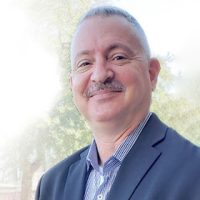Expert Panel:

Prof. Constantine Tam
Head of Lymphoma Service, Alfred Health

Jeff Folloder, Moderator and CLL patient advocate
Our recent CLL Global Research Foundation Town Hall featured CLL Global President, Dr. William Wierda, and Dr. Constantine Tam from Monash University in Melbourne. CLL patient advocate Jeff Folloder moderated the event. Watch the full webinar.
Transcript
Jeff Folloder:
Dr. Tam, we’ve been talking a lot about pills, inhibitors. We’ve been talking about the BTK approaches. T cell transplants, is that a mainstream treatment for CLL? And once we know that, how mainstream is it? And how risky is it?
Prof. Constantine Tam:
Sure. So, that really opens up the new field of car T cells and allogeneic bone marrow transplant. So, we know for quite a long time now that if you have a bone marrow transplant from another person – so not a bone marrow transplant from yourself, but from a brother, sister, or unrelated donor – and you put a new immune system into a CLL patient, that you can cure CLL. Okay? So, that is the one area where we know we can cure. But that’s a high-risk procedure, because the transplant may recognize the patient’s body as being foreign. It causes something called graft-versus-host disease, which is a very difficult situation.
So, traditionally in CLL, we have known about transplant, but we usually kept it in a back pocket for very difficult situations. Where patient has stopped responding to our drugs, or patients have Richter transformation, or something similar.
And more recently, your audience will have heard about car T cells, which is where we do pretty much the same thing, but without the risk of graft-versus-host disease. Which is where we get the patients’ own immune cells, T cells, and we genetically hijack them to attack cancer. And that’s now a mainstream treatment for lymphoma.
But what people actually don’t remember was that the first three patients ever to be cured of anything in the world with CAR T cells were infected CLL patients. So, these are patients with advanced CLL who got CAR T-cell treatment at University of Pennsylvania, and who were cured of the disease.
Now we’ve subsequently done CAR T-cell trials in CLL. And there’s now liso-cel, which is now licensed in the US by my country, but in the US for treatment of advanced CLL. And you do get very good responders as Dr. Wierda reported, especially in combination with ibrutinib, you can people who have very long remissions, often cured.
But those are small numbers. And why are they so infrequent compared to, let’s say, other types of lymphoma? And we think it’s because the starting material, the T cells in the patients, are not all that healthy. And we do car T cells in patients where the CLL has been present for a long time, the patient has had many different types of treatment for the CLL. Their immune system is no longer healthy. And we’re getting really damaged T cells to make our foot soldiers to fight CLL. And we’re not going to have very good outcomes.
So, I think a future research area will be, how can we identify those really high risk patients for which we think eventually they will need some sort of cellular therapy? And how can we bring in car T cells at an earlier stage? How can we improve the fitness of T cells, so that when the patients do get their car T cells, they’re getting a good active product rather than a product that is damaged by the fact that the T cells were not good to start with?
And I think that is a really exciting area, that a single infusion of a car T cell may be the permanent solution to a patient’s CLL and cause cure. But obviously, it’s very expensive. It’s complex. We need to have ways to identify which patients are the best suited for it, and well-suited for it. Also, we need to find a way to produce the best cells possible.

